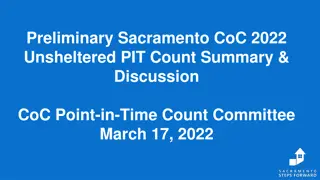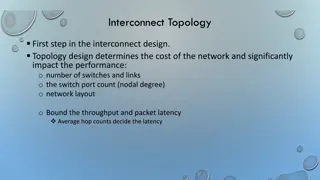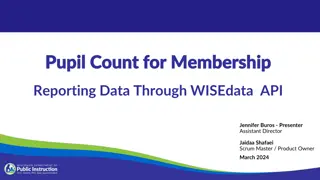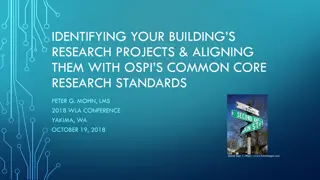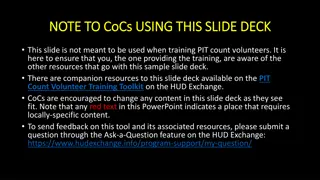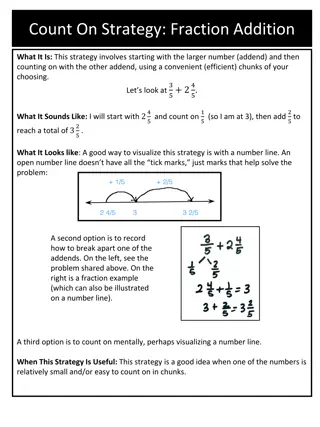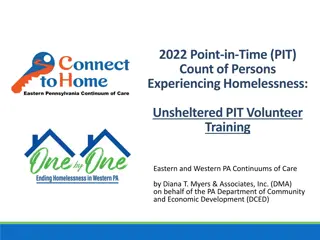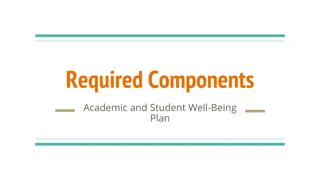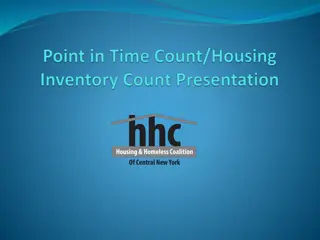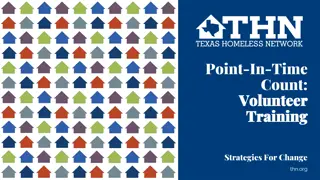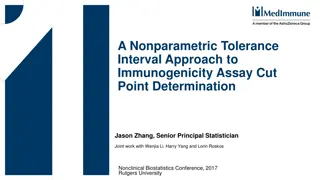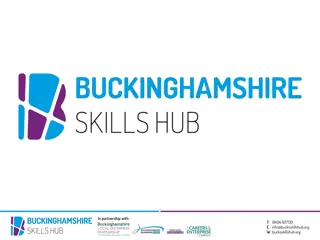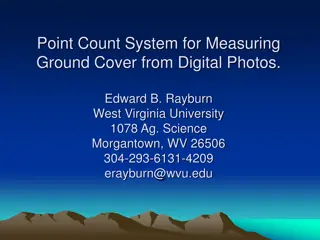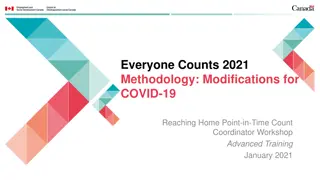Point-in-Time Count Guidance and Overview from OSPI & OHY
The content provides information about the Point-in-Time Count Guidance from OSPI & OHY on January 24, 2019. It includes an agenda overview, details on unsheltered and sheltered counts, involvement of local school districts, and how schools can support the PIT Count. The guidance emphasizes the importance of understanding and serving homeless populations in local communities.
Download Presentation

Please find below an Image/Link to download the presentation.
The content on the website is provided AS IS for your information and personal use only. It may not be sold, licensed, or shared on other websites without obtaining consent from the author.If you encounter any issues during the download, it is possible that the publisher has removed the file from their server.
You are allowed to download the files provided on this website for personal or commercial use, subject to the condition that they are used lawfully. All files are the property of their respective owners.
The content on the website is provided AS IS for your information and personal use only. It may not be sold, licensed, or shared on other websites without obtaining consent from the author.
E N D
Presentation Transcript
Point in Time Count Guidance from OSPI & OHY January 24, 2019
Agenda Point in Time Count Overview Ian Kinder-Pyle OSPI Guidance Melinda Dyer OHY Guidance Cole Ketcherside, My-Le Tang Best Practices for Youth Outreach Keylee Merineau, Thurston County
Unsheltered Count Individuals and households with a primary nighttime residence that is a public or private place not designed for or ordinarily used as a regular sleeping accommodation for human beings, including a car, park, abandoned building, bus or train station, airport, or camping ground. *Vehicles/Boats lacking basic amenities Heating Drinking water Electricity
Sheltered Count Individuals and households living in a supervised publicly or privately operated shelter designated to provide temporary living arrangement (including congregate shelters, transitional housing, and hotels and motels paid for by charitable organizations or by federal, state, or local government programs for low-income individuals).
Point in Time Point in Time Involving Local School Districts in the PIT Count January 14, 2019 Office of Superintendent of Public Instruction Office of Superintendent of Public Instruction Chris Reykdal, State Superintendent
January 24th is PIT Count Day: Can schools help? Schools can support the PIT Count if they wish to become involved in the effort Great way to get to know your Continuum of Care (CoC) partners Learn more about the efforts to serve homeless people in your local community Build relationships | SECTION 12/12/2019 | 7
Before the Event: Planning/Coordinating Schools can coordinate with PIT organizers to assist in selecting family- and youth-friendly count sites, and creating a welcoming environment there; selecting family- and youth- friendly incentives for count participation; recruiting PIT count volunteers; and suggesting other local family and youth service providers to assist with the count. Local liaisons and other school personnel may wish to volunteer to administer PIT count surveys to families and youth experiencing homelessness, provided that survey administration is conducted off school premises and during non-work hours. Many CoCs provide incentives to homeless people who participate in the PIT count. Incentives may include transit passes, meal gift cards, toiletries, backpacks, blankets, and items of clothing. | SECTION 12/12/2019 | 8
Awareness Building Schools may discreetly refer homeless youths and their parents or guardians to community organizations participating in the PIT count Schools may advise PIT count staff and volunteers on where homeless youths may congregate in the community Schools may provide district-level aggregate student data that does not disclose Personally Identifiable Information (PII) (data suppression applied for small N size) Schools may post youth-friendly information about the PIT count throughout schools to inform youth of event locations in the community, when to participate, who the target population is (in this case, youth experiencing homelessness under the HUD definition) and any incentives that may be provided for participation in the count | SECTION 12/12/2019 | 9
Helping with the PIT Count PIT volunteers and school district employees need to be aware of restrictions related to student privacy as well as the administration of surveys Keep in mind, these are federal laws put in place to protect children/youth in schools. | SECTION 12/12/2019 | 10
Student Privacy: Basics The two key pieces of federal legislation that guide how local educational agencies (LEAs) and schools may engage in PIT count planning and implementation are the Protection of Pupil Rights Amendment (PPRA) and the Family Educational Rights and Privacy Act (FERPA.) PPRA addresses the administration of surveys FERPA addresses the sharing of personally identifiable information (PII) about students with third parties. | SECTION 12/12/2019 | 11
PPRA (Protection of Pupil Rights Amendment) Survey administration under PPRA [20 U.S.C. 1232h(c)] requires LEAs to develop and adopt policies, in consultation with parents, regarding The right of a parent or a student to inspect, upon request, a survey created by a third party before the survey is administered or distributed by a school to a student; Any applicable procedures for granting a request by a parent for reasonable access to such survey within a reasonable period of time after the request is received; Arrangements to protect student privacy that are provided by the agency in the event of the administration or distribution of a survey to a student containing certain protected categories of information; and Offering an opportunity for the parent to opt the student out of participation in such surveys. | SECTION 12/12/2019 | 12
FERPA (Family Educational Rights and Privacy Act) FERPA generally prohibits Local Educational Agencies (LEAs) and schools that receive funds under any program administered by the US Department of Education from disclosing student education records, and the PII contained therein without the prior written consent of a parent [20 U.S.C. 1232g(b)] or eligible student [20 U.S.C. n1232g(d)]. Eligible student is defined as a student who has reached 18 years of age or is attending an institution of postsecondary education (34 C.F.R. 90.30). | SECTION 12/12/2019 | 13
Statutory Guidelines Under PPRA and FERPA Guidance addressing the administration of surveys: Protection of Pupil Rights Amendment (PPRA) Guidance addressing the sharing of personally identifiable information: Family Educational Rights and Privacy Act (FERPA) Additional information regarding PPRA and FERPA: Housing/School Partnership on the PIT Count (info sheet): Housing and School Partnership on the Point-In-Time Count Interagency Data Disclosure: A Tip Sheet on Interagency Collaboration https://www2.ed.gov/programs/homeless/ehcy-interagency-data-disclosure.pdf | SECTION 12/12/2019 | 14
Working with schools common questions Q. I work in a school and I ve been asked to assist with the Point in Time count. Am I required to participate? A. No. School district participation in the Annual Point in Time Count is purely voluntary. Q. Is the Point in Time Count the same as the OSPI Annual Homeless Student Data Collection? A. No. These are two separate efforts. The OSPI Annual Homeless student data collection is done in July, and collects different data points than the PIT. | SECTION 12/12/2019 | 15
Working with schools common questions Q. I have a great relationship with my CoC and I d like to help with the PIT Count. What can I do? A. Schools can advertise the community locations where the PIT events will take place, and school staff can volunteer to help with the PIT (on their own time, off school property.) | SECTION 12/12/2019 | 16
Working with schools common questions Q. A PIT volunteer approached my school with PIT surveys and requested that I complete the forms and return them to the volunteer. Can I do this? A. No. Schools cannot share personally identifiable student information (PII) per FERPA rules; and schools cannot distribute, complete, or assist in the administration of PIT surveys on behalf of students per PPRA. Surveys are to be completed at the community locations, not at schools. | SECTION 12/12/2019 | 17
Working with schools common questions Q. I understand that school staff cannot use staff time or resources to assist with surveys, but, I m wondering if the PIT volunteers can come to the school to administer the surveys themselves is this okay? A. No. Due to federal rules (PPRA and FERPA) schools (generally) cannot allow third parties to administer surveys at schools. PIT count efforts are to be directed to community event locations. | SECTION 12/12/2019 | 18
Working with schools common questions Q. Can I call the parent and ask their permission to complete the survey on behalf of the student? What if the parent stays on the phone while we complete the survey together? A. No. Surveys are to be completed off school grounds and at community PIT locations. Q. What if the PIT survey is available online? Can we use school computers to assist with the administration of the PIT surveys? A. No. Participants are to be directed to community locations to complete the survey. | SECTION 12/12/2019 | 19
Working with schools common questions Q. What about a written waiver or a written parent permission form Will these allow the school to share information for the PIT count? A. No. However, this is a complex question. The federal Protection of Pupil Rights Amendment (PPRA) provides strict guidelines for developing local policies regarding the administration of surveys at schools, securing written permission (in advance) of administration, and several other requirements. | SECTION 12/12/2019 | 20
Working with schools common questions Q. Can I post notices in my school about the upcoming PIT Count? A. Absolutely! Schools are encouraged to advertise the upcoming PIT Count and inform students of the date, locations and any incentives for participating. Q. Can I provide the PIT volunteers with the (de-identified) number of homeless students in our district? A. Yes. Aggregate data can be shared (data suppressed for N size.) | SECTION 12/12/2019 | 21
Working with schools common questions Q. If a PIT volunteer provides the school with flyers, posters and other information about the PIT Count, may I pass these along to students? A. Yes. The information can be made available to all students. Additionally, schools may discreetly refer homeless youths and their parents or guardians to community organizations participating in the PIT count | SECTION 12/12/2019 | 22
Resources for PIT National Center for Homeless Education: Data Collection https://nche.ed.gov/data-collection/ National Center for Homeless Education: Housing and School Partnership on the Point-In-Time Count Housing and School Partnership on the Point- In-Time Count U.S. Department of Education: Interagency Data Disclosure: https://www2.ed.gov/programs/homeless/ehcy-interagency-data- disclosure.pdf To identify the local PIT coordinators or get more information, visit: https://www.commerce.wa.gov/serving- communities/homelessness/annual-point-time-count/ To locate the CoC in your area, visit: https://www.commerce.wa.gov/serving- communities/homelessness/continuum-of-care/ To locate the local homeless education liaison in your area, visit: http://www.k12.wa.us/HomelessEd/ContactList.aspx | SECTION 12/12/2019 | 23
Questions? Melinda Dyer, OSPI Program Supervisor McKinney-Vento, Education of Homeless Children and Youth Melinda.dyer@k12.wa.us 360-725-6505 | SECTION 12/12/2019 | 24
Office of Homeless Youth Guiding Vision Every family and youth in Washington State has the individualized support they need so that no young person has to spend a single night without a safe and stable home. Every community has services that are equitable, accessible, effective, responsive, and coordinated.
How we serve homeless youth Programs for youth under age 18 Crisis Residential Centers provide short-term, semi-secure, and secure facilities for runaway youth and adolescents in conflict with their families. HOPE Centers provide temporary residence, referrals and permanency planning for street youth. Street Youth Services connect youth to services and housing through street and community-based outreach.
How we serve homeless youth Programs for young adults age 18 through 24 Independent Youth Housing Program provides rental assistance and case management for youth who have aged out of the foster care system. Young Adult Housing Program providesrental assistance, transitional housing, and case management for homeless young adults. Young Adult Shelter provides emergency shelter beds to young adults.
HUD supplemental guidance on counting youth (2013) Emphasizes the importance of counting youth under 25 Provides guidance on how to include projects serving both dependent youth and homeless youth in HIC/PIT Encourages collaboration with locally funded HHS: RHY programs and local school district homeless liaisons May include youth in count who meet other homeless definitions for CoC planning purposes Unaccompanied youth under 18 counted as households with only children Recommends recruiting currently or formerly homeless youth to assist with count
Urban Institute: Youth Count Process Study (2013) Nine communities across the nation participated in the Youth Count Initiative (including King & Whatcom Counties) Identifies promising practices and recommendations for conducting youth counts
Urban Institute: Promising Practices for Counting Youth Emphasizes the importance of involving youth, engaging youth partners, schools, LGBTQ providers, etc. Advocates for measuring housing instability, rather than homelessness Recommends expanding coverage, using social media to raise awareness, and hosting magnet events to attract youth for the count Avoid duplicate counts to prevent overestimation Improve training and quality control for volunteers
Conducting a Youth Count Chapin Hall: Voices of Youth Count Updated in 2018
Chapin Hall: Voices of Youth Count Phase 1: Establish a Youth Count Leadership Team and Host Initial Team Meeting Phase 2: Hold Focus Groups Phase 3: Prepare for Count: Hold Planning/Strategy Meetings, Recruit Guides/Volunteers, Hold Trainings Phase 4: Conduct Count: Street, Organizational, Come and Be Counted (Magnet Events)
King County (All Home) Count Us In: Homeless and Unstably Housed Young People 2016 Report 2016 was 6th annual count of homeless and unstably housed youth in 72 locations in King County Allows for a deeper dive into scope of youth/young adult homelessness Surveys administered by agency staff/volunteers Complemented King Counties PIT count Provided a variety of services while youth completed surveys Debriefing session was held after the count to celebrate work and collect feedback Washington State Department of Commerce 33
Providers Perspective: Best Practices for Successful Youth Counts & Partnering with Homeless Youth Providers Keylee Marineau, Thurston County Homeless and Housing Response Coordinator Formerly: Program Director, Community Youth Services in Olympia, Washington






